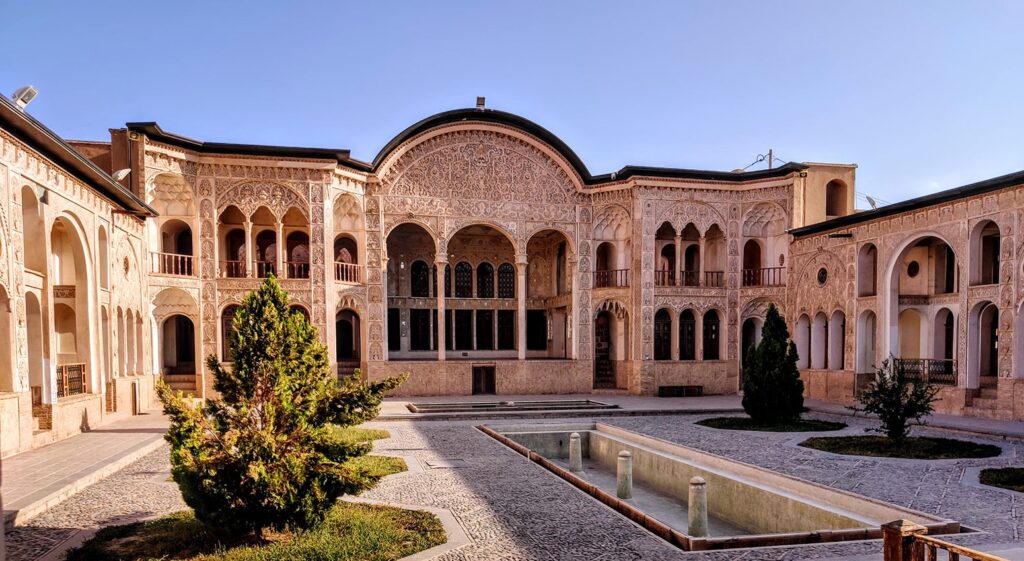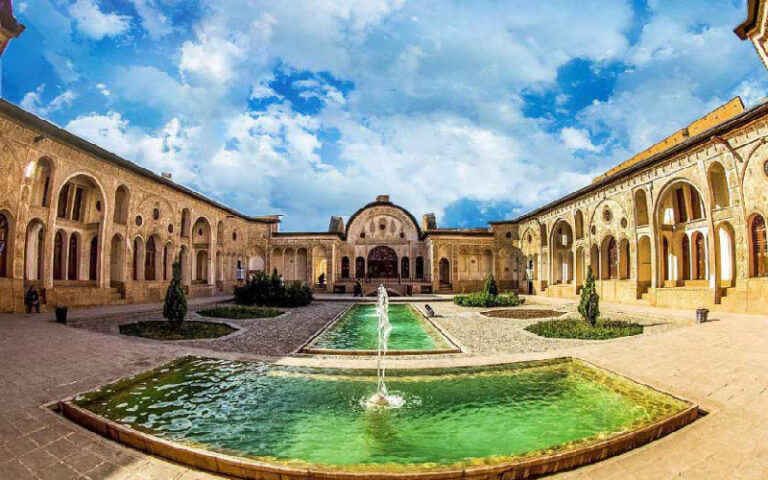
Tabatabaei House is one of the most remarkable examples of traditional Iranian architecture, located in the city of Kashan. Known as the “Bride of Iranian Houses”, this historic mansion was built during the Qajar era by the order of Seyyed Jafar Tabatabaei Natanz, a well-known carpet merchant. With its elegant courtyards, intricate stucco decorations, mirrorwork, and colorful stained-glass windows, this house stands as a true masterpiece of traditional Persian architecture.
History and Construction of Tabatabaei House
This house was built in 1870 by Ustad Ali Maryam Kashani, a prominent architect of that time. He later designed other notable structures in Kashan, such as Borujerdi House and Aminoddole Caravanserai.
Tabatabaei House was designed not only for its aesthetic appeal but also to be perfectly adapted to the hot and dry climate of Kashan. The use of windcatchers (badgirs), central pools, and internal gardens helped regulate the temperature and keep the house cool during the intense summers.
Architectural Features of Tabatabaei House
1. Four Courtyards and Distinct Functional Areas
The house consists of four main courtyards, each serving a specific function:
- Outer Courtyard (for receiving guests and business affairs)
- Inner Courtyard (private living quarters for the family)
- Servants’ Courtyard (designated for house workers and staff)
- Stable Courtyard (used for keeping horses and storage)
This layout follows the principles of traditional Persian architecture, where public and private spaces are clearly separated.
2. Exquisite Stucco Work
One of the most stunning aspects of Tabatabaei House is its intricate stucco decorations, featuring Persian floral motifs, arabesques, and traditional geometric patterns, all meticulously carved to create a breathtaking visual effect.
3. Stained-Glass Windows and Natural Light Play
The house is adorned with beautiful stained-glass windows, which not only enhance its aesthetics but also serve a practical function. These windows filter sunlight to create colorful patterns inside the rooms while reducing the harsh glare of direct sunlight.
4. Natural Ventilation with Windcatchers
Due to Kashan’s hot climate, the house incorporates windcatchers and underground cooling rooms to ensure a steady flow of fresh air, keeping the interior spaces naturally cool.
5. Introverted Architecture and Privacy Protection
Like many traditional Iranian houses, Tabatabaei House follows an introverted architectural design, meaning that all rooms and living spaces face inward towards the courtyards, with no direct visibility from outside. This feature provided both security and privacy for its residents, aligning with Persian cultural values.
Cultural and Historical Significance of Tabatabaei House
Tabatabaei House is not only a symbol of Persian artistic excellence, but it also offers a glimpse into the social and cultural lifestyle of Qajar-era Iran. Today, it stands as one of Kashan’s most important tourist attractions, drawing thousands of visitors from around the world each year.
Conclusion
Tabatabaei House is a magnificent example of traditional Persian architecture, showcasing a perfect blend of aesthetics, functionality, and climate adaptability. This house is not just a historical monument but also a testament to the intelligence and artistic mastery of Iranian architects in designing harmonious and livable spaces.


No comments yet.